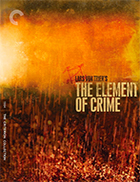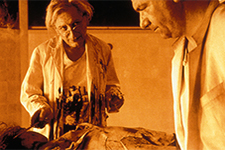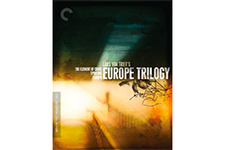| Director: Lars von Trier | | Screenplay: Lars von Trier & Niels Vørsel | | Stars: Michael Elphick (Fisher), Esmond Knight (Osborne), Me Me Lai (Kim), Jerold Wells (Kramer), Ahmed El Shenawi (Therapist), Astrid Henning-Jensen (Housekeeper), János Herskó (Coroner), Stig Larsson (Coroner’s assistant), Harry Harper (Porter 1), Roman Moszkowicz (Porter 2), Lars von Trier (Schmuck of Ages), Frederik Casby (White policeman), Duke Addabayo (Black policeman), Jon Bang Carlsen (Angry policeman) | | MPAA Rating: NR | | Year of Release: 1984 | | Country: Denmark |  |
|  Starting with Breaking the Waves (1996), Danish director Lars von Trier gravitated more and toward grainy, hand-held camerawork and a minimalist aesthetic. His 1998 film The Idiots (Idioterne) was made under the strict tenets of the Dogme 95 collective, and his Palm D’Or-winning Dancer in the Dark (1997), while discarding some minimalism, still relies entirely on low-res digital video. Thus, for those who were introduced to von Trier’s work in the late 1990s, it might come as a shock that, at the beginning of his career, he relied heavily on highly stylized camerawork. To get a real understanding of von Trier’s visual prowess, one must return to his first feature film, The Element of Crime (Forbrydelsens element), an utterly mesmerizing and completely disjointed crime thriller that is more about tone and style than it is about narrative. Taking place in some near-futuristic, perhaps post-apocalyptic Europe, it is an uncanny amalgam of everything from film noir, to science fiction, to Buñuelian surrealism. The first and most striking of the film’s stylistic components is its use of color. In fact, the image is devoid of color outside of various tones of sepia that are, from time to time, strikingly juxtaposed with a harsh, electronic blue that emits from either lightbulbs, fluorescent lights, police sirens, or television monitors. Thus, the visual structure of the film is not far removed from black and white; in fact, at times it looks very much like a black-and-white film that has been tinted. The result is the striking tone of a nightmarish landscape, with the monochromatic image emphasizing the desolate nature of the rugged urban environment in which the story takes place. Shadows and hard contrasting lights are highlighted amid the ruin of urban decay, which is characterized by broken windows, dented cars, and a proliferation of grating and metal chain-link fences. The loosely strung narrative is made even more distant by the fact that it is told via flashback through hypnosis. The narrative is related through the eyes of Fisher (Michael Elphick), a police investigator who has lost his memory. The story he recalls of being called back to Germany to investigate a serial killer who preys on young girls becomes the film’s narrative. Built into this is Fisher’s relationship with his aging mentor, Osborne (Esmond Knight), a once-great police investigator whose publication on the interaction between criminality and environment, “The Element of Crime,” gives the film its title. Fisher also becomes involved with a prostitute named Kim (Me Me Lai), who goes with him on his investigation as he tracks the footsteps of one Harry Grey, the presumed serial killer who may, in fact, not even exist. The narrative is difficult to extrapolate from the individual scenes, and, in the end, it is mostly irrelevant. Even with Fisher’s voice-over narrative guiding the proceedings, the characters’ motivations are cloudy and the general thematic drive of the film is hard to decipher (it has something to do with merging the police investigator and the criminal he is investigating). Yet, for The Element of Crime, this narrative deficiency is not an overwhelming detriment because the visuals hold so much power on their own. Von Trier, working with cinematographer Tom Elling, builds a convincing world out of almost perpetual nightfall. Elling’s camera sweeps with unnerving grace and aplomb, moving as surely though tight, claustrophobic interiors as it does across large, open spaces. The camera is often airborne, looking down on the characters as if to minimize them even further in the reddish-hued world in which they are trapped. Although billed as a crime thriller in the most basic sense of genre classification, The Element of Crime is decidedly more. It sets the stage for much of von Trier’s later work, both stylistically (until Breaking the Waves, that is) and thematically (with its emphasis on inner turmoil). Von Trier’s subsequent output has been questionable, as many critics have seen his forced religious symbolism (Breaking the Waves) and overwrought social critique (The Idiots) as the trappings of an overly ambitious artist striving for more than he can manage. The Element of Crime falls into some of the same trappings (I can easily imagine it being described as “pretentious” and “pointless”), but it is nevertheless a gripping display of visual audacity that is not easily forgotten. | The Element of Crime Criterion Collection Blu-ray |  The Element of Crime is available as part of Criterion’s three-disc set “Lars von Trier’s Europe Trilogy,” which also includes Epidemic and Europa. The Element of Crime is available as part of Criterion’s three-disc set “Lars von Trier’s Europe Trilogy,” which also includes Epidemic and Europa. | | Aspect Ratio | 1.89:1 (Element of Crime)
1.66:1 (Epidemic)
2.39:1 (Europa) | | Audio | English Linear PCM 1.0 monaural (The Element of Crime)Danish Linear PCM 1.0 monaural (Epidemic)English/German Linear PCM 2.0 stereo (Europa) | | Subtitles | English | | Supplements | Audio commentary on The Element of Crime by director Lars von Trier, film and sound editor Tomas Gislason, and cinematographer Tom EllingAudio commentary on The Element of Crime by film scholar Peter Schepelern and filmmaker and critic Stig BjorkmanAudio commentary on Epidemic by von Trier and screenwriter and actor Niels Vørsel Audio commentary on Europa by von Trier and producer Peter Aalbwk JensenSelected-scene audio commentary on Europa by von Trier and actors Jean-Marc Barr and Udo KierTranceformer: A Portrait of Lars von Trier (1997) documentary by Stig Björkman“Storyboarding The Element of Crime” featurette“Anecdotes From The Element of Crime” featuretteInterview from 2005 with von Trier about the Europe TrilogyMaking-of documentaries for all three filmsPrograms on the films featuring interviews with many of von Trier’s collaboratorsTwo short student films by von Trier: Nocturne (1980) and Images of Liberation (1982) Danish television interview with von Trier from 1994“Portrait of Lars Von Trier” featurette “Anecdotes From Epidemic” featurette“From Dreyer to Von Trier” featurette“Anecdotes From Europa” featurette“Lars von Trier Anecdotes” featurette“The Emotional Music Script for Europa” featurette“A Conversation with Lars Von Trier” featurette“Trier’s Element” featuretteTrailersEssay by critic Howard Hampton | | Distributor | The Criterion Collection | | Release Date | January 17, 2023 | | | COMMENTS | | All three films in the “Europe Trilogy” have been newly scanned and restored. The Element of Crime and Epidemic were both scanned in 3K from the original 16mm camera negatives, while Europa was scanned in 4K from its original 35mm camera negative. Restoration work was carried out by Zentropa and approved by Lars von Trier. The transfer of The Element of Crime highlights with stunning clarity and great detail the film’s complex visual structure. As it is similar to a black-and-white film, the main challenge to the transfer was the contrast and black levels, both of which are mostly dead-on. Von Trier constantly infuses the frame with a great deal of hard contrast in the form of lights cutting through the darkness, and the transfer handles all of these scenes very well. The contrast between the sepia tones and the electronic bluish hues are also well-rendered. Epidemic is, simply put, an ugly movie, so even though the transfer is spot on, it still doesn’t look very good. The 16mm portions of the film are extremely grainy with a great deal of noise and hard contrast that makes parts of the image murky and other parts blown out, which is the intended look (or at least how it looked theatrically). The scenes shot on 35mm look much better, with a smoother sheen and good detail. The challenge with Europa is that virtually every shot in the film is an optical and is thus at best a copy of a copy. This results in the film having a slightly soft appearance, although it is sharp enough to make out plenty of detail in the often astounding visuals. The black-and-white image has good contrast and a nice range of grayscale, while the moments of color are appropriately desaturated and slightly unnatural. There is no information in the liner notes about the sources for the soundtracks. The Element of Crime and Epidemic are both in monaural while Europa is in stereo. The only film that sounds a bit problematic is Epidemic, which features quite a bit of aural hiss, but that is surely inherent to the low-budget film’s original soundtrack (and probably intentional). As far as supplements go, make sure you block out about a week of your life if you want to get through it all. Criterion has assembled a massive array of extras, most of which have been drawn from previous releases. We can start with the audio commentaries, of which there are five spread across the three films and all of which were recorded in 2005: The Element of Crime gets two, one from director Lars von Trier, film and sound editor Tomas Gislason, and cinematographer Tom Elling and one by film scholar Peter Schepelern, a professor at the University of Copenhagen, and filmmaker and critic Stig Bjorkman; Epidemic gets one by von Trier and screenwriter/actor Niels Vørsel; and Europa gets two, one by von Trier and producer Peter Aalbwk Jensen and then a selected-scene commentary by von Trier and actors Jean-Marc Barr and Udo Kier. Each of the discs is packed with additional supplements, most of which relate to that particular film, but others of which are more generally about von Trier and his work. On the Element of Crime disc we get Tranceformer: A Portrait of Lars von Trier, an excellent 1997 documentary by Stig Björkman that runs 54 minutes. Conveniently broken up into 10 chapters, it is a fine overview of von Trier’s complex and already controversial career. It includes extensive interviews with von Trier and his filmmaking associates, as well as footage of 8mm and 16mm films he made as a child and his work as a film student. (One complaint: The documentary does not use screen titles to note who the interviewees are, so you have to figure out who they are from the context of their statements.) The documentary covers both von Trier’s early work on his “Europe Trilogy” in the 1980s and his later output in the 1990s (with special emphasis on Breaking the Waves), concentrating on his consistent themes and his renown as a controversial director. “Storyboarding The Element of Crime” is an 11-minute interview from 2005 with cinematographer Tom Elling about how he and von Trier storyboarded the film. A 30-minute behind-the-scenes documentary from 1984 includes footage of the film in production and interviews with von Trier, actors Michael Elphick and MeMe Lai, and executive producer Per Hoist, among others. “Anecdotes From The Element of Crime” is a 20-minute featurette from 2005 that includes interviews with film scholar Peter Schepelern, film and sound editor Tomas Gislason, assistant director Ake Sandgren, executive producer Per Hoist, prop master Peter Grant, production manager Per Arman, gaffer Birger Larsen, and sound recordist Henrik Fleischer. Finally, the disc includes a trailer and two of the films von Trier made while he was studying at the National Film School of Denmark: the experimental Nocturne (1980) and Images of Liberation (1982), a drama about a German officer and his Danish mistress in the final days of World War II. The Epidemic disc opens with “Portrait of Lars von Trier,” a 1991 interview he gave for Danish teleivison. The 17-minute featurette “Anecdotes From Epidemic” includes interviews with screenwriter and actor Niels Vorsel, cinematographer Kristoffer Nyholm, actors Udo Kier and Michael Simpson, film scholar Peter Schepelern, and film consultant Claes Kastholm Hansen. The 150-minute featurette “From Dreyer to Von Trier” consists of an interview with cinematographer Henning Bendtsen, who, as the title suggests, began he career working with Carl Theodor Dreyer and ended with several of von Trier’s films (his second-to-last film was Europa. The disc also includes a very short trailer. The Europa disc starts with “The Making of Europa,” a 40-minute documentary produced in 1991 about the film’s production. Despite the rather shoddy video quality, the doc presents a fascinating journey from the elaborate process of storyboarding to the various stages of production, including behind-the-scenes footage on location and on the set and several interviews with von Trier. “Triers Element” is another 1991 documentary about the film’s production, although this one dedicates significantly more time to an interview with von Trier, and it also includes footage from the production of Dimension, a film von Trier started shooting in 1991 and plans to work on for three decades. “Anecdotes From Europa, a 20-minute documentary from 2005, is exactly what it sounds like: amusing anecdotes about the film’s production told by film historian Peter Schepelern, actor Jean-Marc Barr, producer Peter Aalbæk Jensen, assistant director Tómas Gislason, co-writer Niels Vørsel, and prop master Peter Grant (the best involve Jensen illegally bringing guns into Poland for the shoot and bribing notoriously difficult actor Ernst-Hugo Järegård with Cuban cigars). Also from 2005 are a series of video interviews with cinematographer Henning Bendtsen, composer Joachim Holbek, costume designer Manon Rasmussen, film-school teacher Mogens Rukov, editor Tómas Gislason, producer Peter Aalbæk Jensen, art director Peter Grant, actor Michael Simpson, production manager Per Arman, and actor Ole Ernst. There is also another 43-minute interview with von Trier recorded in 2005 in which he speaks extensively about the “Europe Trilogy.” Lastly, “The Emotional Music Script for Europa” is a 12-minute interview with composer Joachim Holbek. |
Copyright © 2023 James Kendrick Thoughts? E-mail James Kendrick All images copyright © The Criterion Collection |



 (3)
(3)

 The Element of Crime is available as part of Criterion’s three-disc set “Lars von Trier’s Europe Trilogy,” which also includes Epidemic and Europa.
The Element of Crime is available as part of Criterion’s three-disc set “Lars von Trier’s Europe Trilogy,” which also includes Epidemic and Europa.